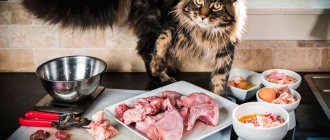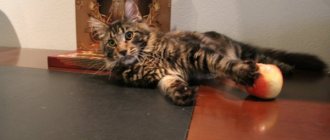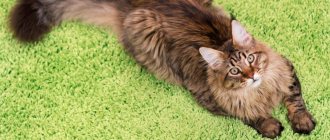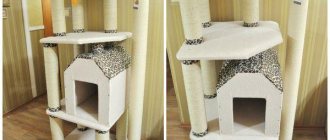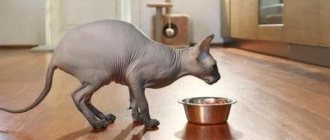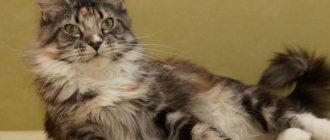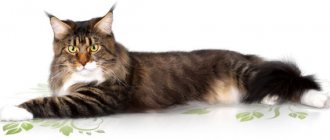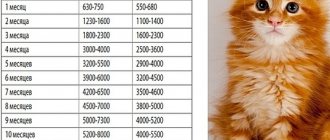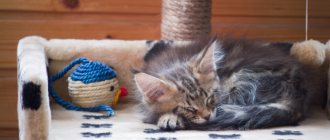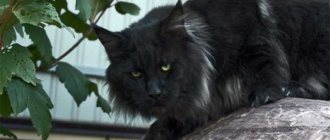The health status of an adult cat is determined by various criteria - from the animal’s behavior to the quality of its fur. But some diseases cannot be detected by external signs. For example, the correct development of a Maine Coon kitten can be judged by how much it weighs. Therefore, a responsible owner must carefully monitor the growth of his pet using special tables.
Size standards and maximum weight
These animals are rightfully considered the largest domestic cats among those breeds that are able to live with humans without any problems. All four-legged champions and record holders for weight and height are Maine Coons. They have significantly outgrown the rest of their competitors. The average weight of representatives of this breed is 8-10 kg for males and 4-7 kg for females.
Like other native species, big Manx cats mature late. They enter a sexually mature state quite quickly - females can give birth to offspring already at the age of 7-9 months, but Maine Coons grow up to 4-5 years.
At the age of 5 years, the weight of a Maine Coon cat remains almost unchanged. As soon as a pet loses its appetite, loses weight and becomes lethargic (even in the absence of other signs of illness), it needs to be shown to a veterinarian in order to exclude the development of diseases, which often pass in a latent chronic form, but necessarily manifest themselves in later stages.
This is interesting! A cat named Omar became a contender for entry into the Guinness Book of Records. By the end of the first year of his life, he had already gained 10 kg, and later each year he added one more. Now the title candidate is 4 years old, the actual body length of this Maine Coon is 1.2 meters and, standing on his hind legs, he can easily take food from the dinner table.
Combating aggressive behavior
Despite their balanced behavior and calm nature, Maine Coons can be aggressive.
This condition is considered normal in the following cases:
- the animal is tired or unwell, or sick;
- fright, a state of fear or shock;
- irritation from external factors;
- fight with other cats;
- strong passion for gaming;
- excited state.
Cats of this breed can bite and scratch both with positive and negative emotions. A sick animal should be left alone and allowed to lie down in a secluded place. If a kitten gets too playful and injures its owner, you can press it to the floor for a few seconds and ignore it for half an hour after the punishment.
Throws on the owner
Signs of aggressive behavior in cats include hissing and lunging at people. This is how the animal prepares for self-defense when it feels threatened or in danger. If a representative of this breed perceives the owner as an enemy and is very irritated, you should leave him alone and give him time to calm down. And you will have the opportunity to analyze the situation and understand what provoked such a reaction.
Causing injury
An individual of any age can injure or injure a person. Cats bite when their teeth change or during puberty. To avoid injury, you should purchase special toys for your pet at the pet store that can be chewed.
Problems arise when cats bite and scratch their owners in a fit of aggression. This behavior must be stopped immediately. Otherwise, it will be difficult to defend the position of leader in communicating with this breed. You can punish by splashing water in the face or shaking the withers. Then a short period of ignoring and reconciliation.
Incessant meowing
Meowing is a way to attract attention. Most often, cats communicate in this way about hunger or thirst. But it is possible that the animal is feeling unwell or requires affection
When a kitten meows for a long time and persistently, it means he needs the owner’s participation. The main task is to identify his needs and help
But it is possible that the animal is feeling unwell or requires affection. When a kitten meows for a long time and persistently, it means he needs the owner’s participation. The main task is to identify his needs and help.
Read with this
What is the weight of an adult Maine Coon: the difference between a cat and a cat
In adult Maine Coons, there are significant differences between the weight and height of male and female cats:
- Cats are heavier and longer. A 3-month-old Maine Coon should weigh more than 2 kg, a one-year-old - from 6 to 8.5 kg. Castrated males traditionally exceed the average by another 2-3 kg. This is due to the lack of sexual activity.
- Cats are always smaller and more graceful than males. At 3 months they should weigh about 2 kg, and by the year they gain on average up to 5 kg. As adults, sterilized cats “eat” another 3 kg.
Most often, the weight of an adult Maine Coon cat is around 6-7 kg. Veterinarians do not recommend going beyond these averages, and in case of overeating or weight gain for other reasons, the animal is prescribed a gentle diet or fasting days.
Other differences between a cat and a female cat are in the area of external characteristics that do not depend on the size to which the Maine Coon grows.
Important! Felinologists have compiled a special monthly weight table for Maine Coons. Deviation from it means the presence of problems with health and general development.
A little history
This breed was first mentioned in literature in 1878 in the United States of America. Because of the original appearance, there is a version that this breed is a cross between a cat and a lynx, and even more interesting - a mixture of a cat and... a raccoon! And all because of the tassels on the ears, like a lynx, and often a striped tail, like a raccoon. But more on that later.
The most likely version of the origin of Maine Coons is that they descended from American shorthair and foreign longhair cats. At one time in America there were even special nurseries where this breed was bred.
Maine Coon weight by month
Newborn Maine Coon kittens weigh from 120 to 180 grams, although very small (80 g) animals are often viable. Experts distinguish 2 initial stages of kitten growth:
- Neonatal cycle – first 4 days. At this time, development is highly dependent on the complexity of labor and birth order.
- Sucking month. The only food for the baby is mother's milk and in any case adds at least 10 g to the baby's weight every day. But the normal value is 5-8 times more (50-80 g/day).
Girls weight
The average weight of a newborn cat is 100-150 g.
- In the first month of life, this figure reaches 600-700 g. Small cats can weigh 0.55 kg, and larger individuals can weigh up to 0.75 kg.
- At 2 months the values double again - 1.0-1.55 kg.
- At 3 months, a Maine Coon (girl) should already weigh 1.5 - 2.3 kg and then add about 40% of total body weight every 30 days.
By 6 months (3-4 kg), active weight gain stops - now before a year, cats will gain another half weight and should weigh from 4.5 to 6 kg. At this age, Maine Coon girls grow more slowly than boys.
Boys weight
The average weight of a newborn male is 150 g. In the first weeks of life, the baby should gain about 40% in weight. At the age of 1 month, a Maine Coon kitten should weigh 0.7-0.8 kg.
Then the cat’s body weight increases evenly. At 4 months the weight of a Maine Coon is about 4 kg. Every next 30 days brings an additional kilogram. It's very easy to remember. At 5 months, the Maine Coon weighs 5-6 kg, at 6 months – 6-7 kg, and at 7 months, the Maine Coon should still weigh the same 6-7 kg (or a little more), because the period of active growth has ended.
By the year the cat will add a couple more kilograms, and all further records will be set only closer to the stage of full adulthood - after 3 years.
Table
Maine Coon weight by month (feline and male development chart):
| Age | Boys (kg) | Girls (kg) |
| At birth | 0,15-0,18 | 0,12-0,15 |
| 1 Week | 0,2-0,25 | 0,2-0,25 |
| 2 weeks | 0,3-0,35 | 0,3-0,35 |
| 3 weeks | 0,45-0,5 | 0,4-0,45 |
| 1 month | 0,65-0,8 | 0,55-0,65 |
| 2 months | 1,2-1,5 | 1,0-1,3 |
| 3 months | 1,9-2,4 | 1,5-2,0 |
| 4 months | 3,3-3,8 | 2,8-3,3 |
| 5 months | 4,0-5,5 | 3,5-4,0 |
| 6 months | 5,0-6,5 | 4,0-4,5 |
| 1 year | 6,0-9,0 | 5,0-6,5 |
| 2 years | up to 10.0 | up to 7 |
| 3 years | 12,0-13,0 | 7,5-8,0 |
*All data on the weight of small Maine Coon kittens should be considered as an example only. The development of animals depends on the conditions of detention, nutrition, physical activity, health and other factors.
Feeding
Feeding frequency:
- 3-4 months - 5-6 rubles/day;
- 4-6 months - 4 rubles/day;
- 6 months-1 year - 2-3 rubles/day;
- from a year – 2 rubles/day.
What to feed kittens
Ready-made food: must be labeled “for kittens up to 3 months,” “for kittens up to 10 months/1 g.” Do not mix different types of food.
Natural food. What to feed small Maine Coons:
- cottage cheese (daily);
- low-fat meat (chicken, rabbit, veal, turkey) without skin, bones (daily);
- boiled, pureed vegetables (daily);
- eggs (1 ruble per week);
- boneless fish (1-2 rubles per week);
- children's canned meat and vegetables (several times a week);
- offal (several times a week, starting from 4 months of age);
- vitamin supplements (according to the instructions on the package).
Forbidden:
- ready-made economy class food,
- lamb, pork,
- spices, salt,
- porridge,
- roast,
- tomatoes, eggplants,
- excess seafood, fish (can cause urolithiasis).
Feeding adult Maine Coons
The diet for big Maine Coon cats is similar in composition to the diet for kittens, but the amount of meat must be increased. Include soups and grated cheese in the menu. Add greens and sprouted cereal grains to the food. This cleanses the stomach. Daily calorie content is at least 60 kcal/kg, the amount of protein is 10 g/kg.
Give food at the same time every day. The schedule cannot be violated, otherwise the cat may wake up the owner early in the morning or in the middle of the night, begging for food. If your pet still interferes with your sleep, do not punish him. Chat with him, pet him, but don't feed him. Optimal: feeding before leaving for work and 2 hours after returning home.
Feeding castrated and sterilized animals.
Main problems: possible obesity, development of urolithiasis.
Ready-made food: a special diet is required. You should not give food that contains a lot of phosphorus and magnesium. Follow the dosage to prevent overeating.
The pet must drink enough water (its volume should be 3 times more than the volume of food). If the animal drinks too little, pre-soak the food or give canned food. Alternatively, feed him natural food without mixing it with dry food.
Natural food: exclude sausages, any products processed with salt, food chemicals. Salt should not be added to the food. Diet composition:
- boiled lean meat + broth,
- fish (river only, 1 rub./week),
- boiled offal (1 rub./week),
- eggs,
- low-fat fermented milk products (2-3 rubles/week),
- porridge (rice, buckwheat, semolina, wheat, corn),
- raw and boiled vegetables (carrots, zucchini, pumpkin, beets, cauliflower),
- fresh greens (grass purchased at a pet store or sprouted at home, sprouted cereal grains).
Maine Coon height and weight by month
Unlike the table of a kitten’s weekly (monthly) weight gain, none of the experts describes the growth of the Maine Coon in detail. In fact, the development of the animal occurs unevenly - during the first weeks the cat really quickly increases in size and overtakes its outbred peers.
Also, a lot depends on the conditions of detention - an active Maine Coon, not limited in movement and games, always develops better than pets who live in more modest conditions. But later nature will put everything in its place.
The dimensions of an adult Maine Coon are approximately the same. Its length is about 1 m, and its height at the withers is 30-35 cm. Giants grow up to 40 cm or more, but these are truly rare specimens. Sometimes they try to compare the size of an adult cat with the height of a person (child), but this is completely wrong. The length of the Maine Coon takes into account the parameters “from tip to tip” (nose to tail), and its body is not so impressive. At 8 months, the Maine Coon's weight approaches 7-8 kg, and its height already allows it to rise on its hind legs and take food from the table.
This is interesting! Champion Maine Coons allegedly grew up to 1.35 m in length, but such rumors have not been officially recorded anywhere. And the current record holder has impressive dimensions - his height of 123 cm is confirmed by the Guinness Book of Records.
Care for eyes, ears, teeth and claws
From time to time, kittens may develop crusts in the corners of their eyes - there is no need to be afraid of this, because people’s eyes also sometimes turn sour after sleep.
These crusts can be removed with a cotton swab dipped in boiled water (it is better to buy a special product at the pharmacy), swiping from the outer corner of the eye to the inner one.
But if the discharge appears frequently and is heavy, you should contact your veterinarian.
Little fluffy will happily make some noise at home
The ears should be examined regularly, at least once a week. Healthy ears are pink, clean, without discharge or crusts.
If your kitten begins to scratch its ears frequently and intensively, you should contact your veterinarian. This should also be done if redness and discharge are detected.
The presence of a small amount of sulfur is acceptable - it can be removed with a cotton swab dipped in a special solution.
The gums should be pinkish, without red edges along the teeth line. Bad breath may indicate the presence of the disease.
Particular attention should be paid to the teeth if the pet eats soft food. At about 4 months of age, kittens' teeth change.
The undeniable advantage of the Maine Coon is its peaceful and flexible character.
Maine Coons have large claws, so they have to be trimmed regularly.
It is very important not to damage the blood vessels - the blood will flow for a long time, and after that the pet will limp for some time. The claws need to be trimmed only across, having carefully examined them before doing so - the blood vessels are quite clearly visible
The claws need to be trimmed only across, having carefully examined them before doing so - the blood vessels are quite clearly visible.
There must be a scratching post in the house - it will save the furniture and increase the length of the period between trimming the claws.
How old do Maine Coons grow?
Maine Coons grow up to 5 years old. In some individuals, this process is completed earlier - it all depends on the conditions of detention, nutrition and genetic data of the cat. For example, the table indicates that at 3 months a Maine Coon should weigh 2-2.4 kg, but the scales show the owner other, lower numbers. If the baby is healthy, then there is no need to worry - over time, the Maine Coon will gain the missing kilograms.
In Maine Coon cats, monthly weight gain may also differ from the data indicated in the table. Most often this happens closer to the year, when females enter the puberty phase. At this time, all efforts are devoted to the formation of internal organs, and growth slows down. Later, after the first mating, the cat can quickly recover and even grow.
Important! An indirect indicator of how big a Maine Coon will grow is its parents. Large offspring are always born from equally tall and heavy male cats.
No to artificial records
Most often, a weight of over 10 kilograms is observed in “artificial” cats: their diet contained a lot of dietary supplements, which caused metabolic disorders. Under no circumstances should you believe the myths about cats weighing 20 kilograms and chasing weight “records” - this is a sure path to illness and premature death of the animal.
Maine Coons should not be overfed: excess weight provokes diseases of the heart, lungs, internal organs and joints. Representatives of this cat breed are distinguished by good health and endurance, but they also have an innate tendency to cardiomyopathy, spinal muscular atrophy, and hip dysplasia. Excess weight increases the likelihood of developing these difficult-to-treat ailments.
Why is my cat not growing or losing weight?
The main reasons that affect weight loss or slow growth of a Maine Coon include:
- Small Maine Coon kittens, which are the last born in the litter, usually weigh less and cannot compete for mother's milk on an equal basis with the rest - owners have to carefully monitor that each cub receives its portion of food.
- The weight of a Maine Coon may differ by 10-20% from the weight indicated in the tables and there is nothing to worry about. But if the situation does not change over a long period of time, then you should contact a veterinarian.
- Timely treatment for external and internal parasites reduces the risk of weight loss in Maine Coons.
- In the formation of a Maine Coon, its lifestyle plays an important role - active games and appropriate physical activity help improve the growth of the animal.
A healthy Maine Coon always grows to 5-8 kg, and further weight gain will depend on the conditions of the cat’s keeping and nutrition.
How to educate?
The Maine Coon is a fairly “correct” animal, but not all important responsibilities will be accepted by it right away. This is not only and not so much about going to the toilet in the right place, but about the general rules of behavior in the apartment and the habit of not the most pleasant sanitary and hygienic things like bathing or combing. All this is included in the concept of raising a pet.
The meaning of the above procedures for a cat is unclear, and they themselves are not pleasant, so do not be surprised if a good-natured animal suddenly resists and even bites. A child should be accustomed to procedures from childhood, ideally when he is tired after playing, then he is more relaxed. Start with a short imitation of an unpleasant activity - for example, at first just turn on the hair dryer in the presence of the baby when he eats so that he gets used to the sound, then bring it closer without aiming at the pet, even later direct the air stream at the cat for literally a few seconds, and only At the end, gradually increase the duration.
Deviations from the norm
Insufficient weight gain and decreased body weight are allowed only during the initial stage of growth, during the first week of life. At the neonatal stage, weight gain and height depend on the characteristics of labor.
If an animal whose age is more than a couple of months loses weight, then it is necessary:
- introduce more high-calorie foods into the diet;
- make a competent change in diet;
- supplement the diet with a vitamin-mineral complex;
- use dietary supplements in feeding that stimulate the appetite, as well as quickly normalize the functioning of the stomach and intestinal tract.
It should be noted that at three to four weeks the kitten’s body weight may gradually decrease, which is explained by the transition of the pet from mother’s milk to solid food. And starting from seven weeks, the animal’s weight gains again.
The owner of a Maine Coon should be wary not only of the pet’s underweight, but also of the pet’s excessive body weight. If necessary, you should consult with veterinary specialists who can correctly determine the cause of deviations from the normal weight and height of the Maine raccoon cat.
Safety
Children should not be allowed to play with the kitten without adult supervision - they may accidentally harm it.
It is also worth remembering the curiosity and activity of Maine Coons - you should hide from them all objects that could lead to injury (needles, threads, bags, etc.).
The list of dangerous items includes everything that can interest a small child and harm him.
With Maine Coon kittens there will always be spring in the house
It is also advisable to remove indoor plants from the apartment - many of them are poisonous to cats.
The most common of them are: azalea, dracaena, mistletoe, philodendron, ivy, wisteria, rhododendron, belladonna, alpine violet, orange, pink laurel, poinsettia, sweet pea.
What affects a kitten's growth
Maine Coons cannot be compared to other kittens from birth. They are much larger and heavier. The minimum weight is one hundred and twenty grams. The body weight and development of a kitten into an adult depends on several factors, both independent of the owner and of care.
The growth rate is influenced by these factors:
Number of kittens at birth
The weight of kittens greatly depends on the number of representatives of the breed born at the same time. The fewer kittens born at the same time, the greater the weight of each. And vice versa - more kittens, each weighing less. A female can bear a certain number of kittens, determined by nature, and their weight is also determined. However, even if the kittens are weak at first, this problem can be corrected with vitamins and nutrition.
In the first days of life, you need to pay special attention to the mother, make her diet more varied and rich in vitamins. This all directly affects the kids.
Condition of the animal at birth
Weak, wimpy kittens who have problems with intrauterine development gain weight more slowly and do not develop as quickly as their brothers and sisters. There is no need to worry. Over time, if all feeding standards are followed, the babies will become strong and resilient. But sometimes the litter is “rejected” and the kittens are dwarfs from birth.
Maine Coon breed
If the breed is “pure”, then the kittens will grow faster. This factor is explained by the fact that the gene pool of the breed will be stronger and hereditary traits will appear more clearly against this background. Therefore, such kittens will be larger, stronger and healthier from birth.
Representative gender
Over time, differences appear not only in weight, but also in growth rate. At 3-4 months, males will be significantly larger than females.
Mother's weight
The more kittens the mother has, the better her health, the faster the growth of the offspring will be.
Therefore, it is important to monitor the mother’s health during pregnancy. She should receive all useful microelements and vitamins
Hormonal drugs
The use of medications by a mother cat for medicinal purposes can cause disruption of the animal’s endocrine system, and this has a negative effect on the kittens. During pregnancy, it is better to limit the consumption of foreign drugs to ensure that the offspring is healthy and strong.
Combination of genotypes
The genes of both parents lead to the creation of unique traits, the formation of a stronger or, conversely, weaker kitten, and this accordingly affects the speed of development of the offspring.
It is important to remember about external components during the development of offspring:
The place, or rather the cleanliness and hygienic conditions in which young offspring grow; Stress, which can be caused by temperature changes, loud noise, other animals that behave aggressively or too loudly - all this affects the condition of the kittens and directly affects their growth; The condition of the mother is important; her diet during breastfeeding should be balanced and extremely nutritious.
What should you not feed?
A number of foods are prohibited for this breed.
- Poorly digestible meat and poultry - pork, fatty lamb, goose, duck.
- Almost all fish. In nature, coons do not eat fish, so their digestive system is not adapted for such food.
- Bones. A cat can harm itself with sharp fragments of bird and fish bones.
- Sugar in any form disrupts metabolism.
- Salt and spices damage the stomach as they are not digested and can lead to the formation of kidney and liver stones.
- Boiled and smoked sausages, canned food. Contains many harmful additives.
- Potatoes, peas and other legumes. Causes bloating and disrupts digestion.
Some tips
Maine Coons are fed food at room temperature, which should be slightly warmed up. Up to two months, kittens are given food 5-6 times a day, gradually reducing (as they grow) the number of feedings and increasing the portion size. Adult pets are fed morning and evening. A balanced food contains at least 40% protein, 30% fat and 2% fiber. An adult cat can eat up to 500 grams of food per day.
